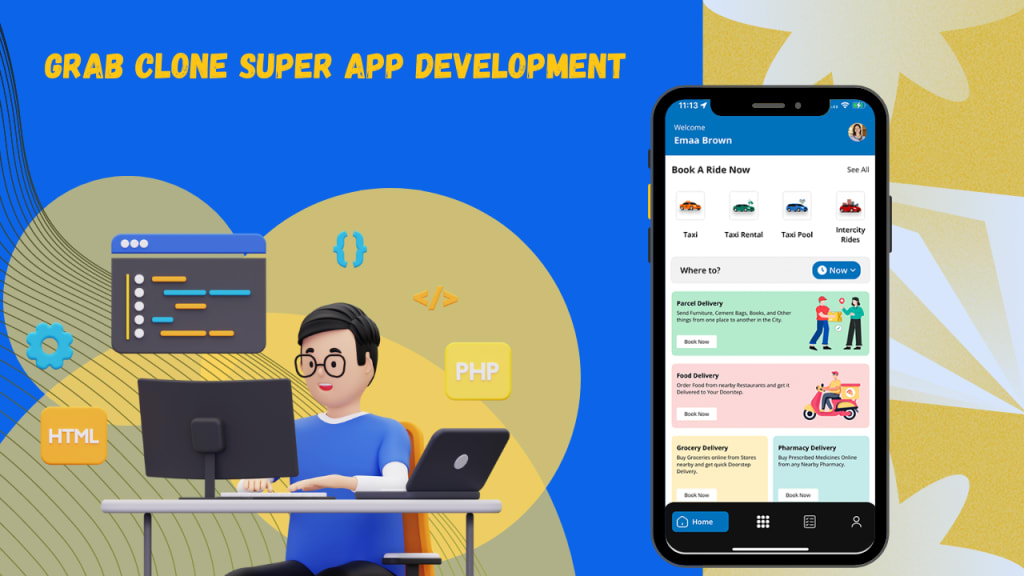Understanding Structure Of Grab Clone Super App Development
Grab Clone Super App

The number of developers required to develop a Grab Clone App depends on the features and the number of components. However, it doesn’t affect the team structure, as at least one person is required to fulfill the role. In this blog, you will learn about the app development team structure, keeping the Grab Clone App in focus.
Introduction
Ride-hailing, food delivery, and digital payments are the three major backbone services that separate a company. Grab from Thailand excels in all three formats. However, when launched in 2016, it was just a simple taxi-booking mobile app for the Southeast Asian population. Today, Grab offers various on-demand services besides ride-hailing, such as food, grocery, courier deliveries, and online payments.
Team Structure in App Development
Finding an effective mobile app development team to kick-start your Grab Clone business should be the first step toward success. However, before moving ahead, it’s worth noting that the number of people for each position depends on your project size. For instance, the Grab Clone app package offers Android and iOS apps. There are not one but six apps for the user, driver, and restaurant.
Furthermore, time and budget are crucial in Grab Clone App Development and team structuring. For instance, having a big budget can allow you to hire one full-stack developer. In the same way, you can hire 3-4 mid-level programmers to save more time. Overall, team structure can be much more complex than it used to be. However, as long as you know about roles and responsibilities, you can cut through all the jargon and hire smartly.
Hierarchically, an ideal team structure consists of:
● Project manager
● UI/UX designer
● Android developer
● iOS developer
● QA engineer
● System analyst
Roles and Responsibilities of Mobile App Developers
Modern-day developers follow an agile methodology, which requires them to test and update a feature multiple times. As a result, they have several responsibilities that largely require them to manage the Grab Clone-like app lifecycle. code, support, and collaborate with UI/UX designers and engineers to squash any known bugs in the system.
Now, a standard Grab Clone has multiple screens, from logging in to giving out a review. It connects the user app to other platforms to process the booking. One developer can do this step with the help of a QA engineer, but it might take several months to clear one app. You'd need three proficient developers to have six apps ready for launch within the same development timeline.
However, this number could increase with planning and design blueprints. Based on such blueprints, the developers will begin the iterative coding steps. When it’s done, the project is deployed, and the main focus shifts to support and maintenance. Moreover, an app developer can also be tasked with coding networking servers, i.e., performing networking tests.
The Case of Grab Clone
Till now, you have learned about the role of app developers and the basic team structure of developing an app. But what about the app itself? Today, on-demand apps are responsible for covering every service, from taxi booking to food deliveries. In this process, they can partner with hundreds of drivers and customers.
What that means in terms of team structure depends entirely on your budget. As mentioned earlier, developing an app like Grab requires creating two user apps, two driver apps, two restaurant apps, a website, and an admin panel. Along with user, driver, and restaurant web panels, there are taxi booking panels, billing and dispatch panels, and hotel taxi booking panels.
All these platforms, apart from the native applications, take hundreds of hours to design and develop themselves. Therefore, it is imperative in your case to get a hold of these platforms without blowing your budget very early. Although it is difficult to sustain a Grab Clone Super App project after a few months, the most challenging part comes in the end.
Starting an On-Demand Delivery Business with Ride-Hailing Service
Team collaboration is as important as receiving critical feedback through active communication. Irrespective of starting or running a business, the value or ethics related to people always come first. After all, integrity and compassion towards one another start from within. That said, most modern entrepreneurs focus largely on the work rather than the people. And the same applies to on-demand delivery businesses like Grab Clone.
Furthermore, Grab offers taxi booking and on-demand delivery of food items, groceries, medicines, and much more. Adding all these services, each with its own features, works on a commission business model. You’d have to add payment options, feedback boxes, and an admin panel for the datasets. Making everything work as you would have intended takes a streamlined approach. The same translates to team structure. As your situation is explained in the following manner, three main approaches exist.
Hire Everyone (In-House)
Usually, the in-house hiring process comes much later in the business development phase. Various investors fund the business when the business owner has proven its worth in the market. With massive capital, the business owner can hire new developers and replace the old ones working remotely (layoffs) or invest in marketing and promotions. However, the first step is always the hardest, i.e., proving your own worth by spending minimally. This phase is the most important time in an entrepreneur's career to learn the true meaning of being frugal.
Delegate Everything (Outsource)
Traditionally, many third-world countries took off with a wave of new-age services in the 1990s. Their work rate adjusted to inflation has been a game-changer for many business owners from first-world countries. Part of the reason is getting the same quality of service at a fraction of the cost. It has led many companies to freely outsource their work using the internet. However, only software or app development niches mainly related to IT have seen an overwhelming response.
Buy All-At-Once (White-Label)
Unlike in-house or outsourced, white-label takes the best pros and curates a highly customized solution for instant business launch. For instance, the success of a Grab-like application in Thailand has urged business owners to design and develop a similar app. As a result, most mobile app development companies built a replica of Grab, also called Grab Clone App, so they can use it for their own purpose. However, it is hard to find professional white-label firms that offer clone apps because they are two different things. Most professional white-label firms also dabble with clone apps so that budding entrepreneurs can white-label the Grab clone from the same place.
Understanding the White-Labeling process
Think from the perspective of a platform offering on-demand delivery services along with taxi booking. On-demand here translates into services that are fulfilled within a set timeframe. Such apps offering on-demand services must be fast, agile, and robust. Therefore, a high-performing native language is usually coded into them with numerous APIs in line with a set number of screens. However, between these, a straight line of action takes the business owner straight to the app, skipping the whole design and development process.
On average, the white-labeling process takes 1-2 weeks for every platform involved. In other words, think about a mobile application built by third-party developers from a country with very low mobile development costs. Therefore, you would own 100% licensed source code, including a highly customized script ready to take action.
Conclusion
Attaining a handful of developers for your Grab Clone app project depends on the time. The more you hire, the faster your project will finish. However, the best solution is to make a budget and a week-to-week timeline to minimize spending. However, you’d have to hire at least three app developers for a super-app project like Grab Clone.
About the Creator
Frances Harper
Frances Harper is a technical writer of ondemandclone development company. He loves exploring new things and sharing writeup skill with others. He has an extensive experience in building succesful strategy for app-based industry.
Enjoyed the story? Support the Creator.
Subscribe for free to receive all their stories in your feed. You could also pledge your support or give them a one-off tip, letting them know you appreciate their work.






Comments
There are no comments for this story
Be the first to respond and start the conversation.